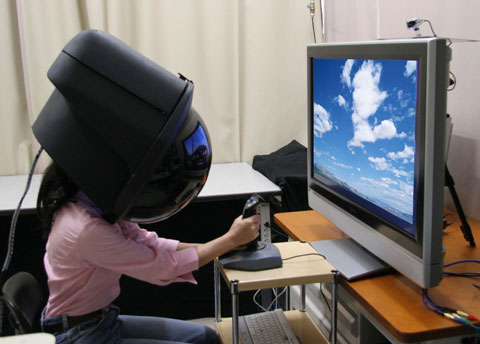Displays. LCDs are getting cheap. Who can’t afford a 17″ these days with rebates? Ok, what’s next?
Organic Light Emitting Diode or OLED displays. From Wave Report tutorial on OLEDs:
Organic Light-Emitting Diode (OLED) technology
An OLED is an electronic device made by placing a series of organic thin films between two conductors. When electrical current is applied, a bright light is emitted. This process is called electrophosphorescence. Even with the layered system, these systems are very thin, usually less than 500 nm (0.5 thousandths of a millimeter).
When used to produce displays, OLED technology produces self-luminous displays that do not require backlighting. These properties result in thin, very compact displays. The displays also have a wide viewing angle, up to 160 degrees and require very little power, only 2-10 volts.
OLED displays have other advantages over LCDs as well:
* Increased brightness
* Faster response time for full motion video
* Lighter weight
* Greater durability
* Broader operating temperature ranges
There are two types of OLED displays – passive and active. These distinctions, plus narration about the OLED 2001 conference and the market challenges that the technology will face can be read in WAVE 151 or as a separate article on the WAVE Report site.
[…]
Thin and no backlights needed! I also read a year or so ago, they have figured out how to stack the blue/green/red diodes, rather than placing them in a small triangle to make a pixel. That breakthrough will provide even higher quality displays, tripling the resolution.
BUT WAIT! There are also PLEDs – Polymer LEDs. And I found them when the search box had PLED as a typo by me in it. So I got edumacated by mis-spelling…
From Cambridge Display Technologies FAQs:
How do PLEDs displays work?
PLED displays are made by applying a thin film of light-emitting polymer onto a glass or plastic substrate coated with a transparent electrode. A metal electrode is sputtered or evaporated on top of the polymer. Application of an electric field between these two electrodes results in emission of light from the polymer. When a current is applied, electrons from the cathode migrate through the cell and meet positive ‘holes’ migrating from the anode. When they meet, they form so-called excitons, and as the electrons drop into the holes, energy is released as light. See also How PLEDs work.
[…]
How big can PLED displays be manufactured?
Displays up to 40 in. have been demonstrated and ultimately, because of the scalability of ink jet printing, even larger displays are expected. The relative simplicity and flexibility in manufacturing means that different technology sets could enable modular display devices that can be tiled to produce very large displays.
Approximately how much will it cost?
Costs to manufacture, when compared with LCDs of comparable volume and maturity of production tools and processes, are expected to be 20-40% lower.
What are PLED displays used for?
PLED has four key applications:
* Large single pixel displays can be used in lighting applications, replacing incandescent and fluorescent bulbs.
* Low information content displays where inorganic LEDs are currently used: video, hi-fi, shaver, watch etc
* Displacement of cathode ray tube (CRT) or LCD (traditional television and computer display applications): mobile phones, digital assistants, computers and televisions.
* New display applications for which PLED characteristics make it uniquely suited. E.g., replacement for traditional automotive instrument panel, dynamic advertising applications, graphical signs for point of sale or purchase, electromechanical signage, bio-medical testing.
See that? Print them with an inkjet like process….and, like OLEDs, cheaper than LCD technology. I have also read that the LED displays can be put on a flexible/bendable (not foldable) base, leading to all sorts of new ideas for paper thin display surfaces that are not required to stay flat all the time to be usable.
Now, never fear, the scientists are even father out with Quantum Dot display technology…
QD Vision has this to say about the practical stuff, you know like price and performance:
[…]
QD Vision has developed a prototype of a 32-by-64 red pixel QD display that uses the new printing process. Quantum dots were printed within a sandwich of organic semiconductor thin films, which when driven by a current, enable quantum dots to emit light. The quantum dots are 5nm inorganic semiconductor nanocrystals synthesized by QD Vision.
Quantum dots displays are expected to provide sharper colors and cost less to make than the competing technologies like organic light-emitting diodes while using a similar manufacturing process to OLEDs.
[…]
MIT Labs have been working to develop the technology for a while now:
Quantum-dot LED may be screen of choice for future electronics
December 18, 2002
CAMBRIDGE, Mass.–MIT researchers have combined organic materials with high-performing inorganic nanocrystals to create a hybrid optoelectronic structure–a quantum dot-organic light-emitting device (QD-OLED) that may one day replace liquid crystal displays (LCDs) as the flat-panel display of choice for consumer electronics.
[…]
CREATING BRIGHT LIGHT
The QD-OLEDs created in the MIT study have a 25-fold improvement in luminescent power efficiency over previous QD-OLEDs. The MIT researchers note that in time, the devices may be made even more efficient and achieve even higher color saturation.
“One of the goals is to demonstrate a display that is stable, simple to produce, flat, high-resolution and that uses minimal power,” Bulovic said.
The MIT researchers were inspired by advances in all-organic LED (OLED) technology. OLEDs, which can be used to create TVs or computer screens only a fraction of an inch thick with the same brightness as LCDs, have been making their way into commercial electronic devices. The MIT group envisions that QD-OLEDs will in time become complementary to OLEDs because they can be built on the same electronic platforms with compatible manufacturing methods.
[…]
So, the future for your display surfaces/devices looks bright and inexpensive, too!












